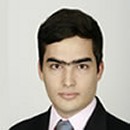|
Plenary
Lecture
Combining Virtual and Augmented Reality to Improve the
Mechanical Assembly Training Process in Manufacturing

Professor
Amaury Andres Peniche
Gonzalez
EAFIT University
Colombia
E-mail: apeniche@eafit.edu.co
Abstract:
Nowadays, the industrial sector and specially
manufacturing companies, have a huge challenge trying to
train the workforce while maintaining up to date with
the technology, machinery and manufacturing techniques
involved in the production process. For that reason this
sector claims for effective, in time and quality,
training methodologies that do not interrupt or
interfere with the continuous workflow of the company or
its technological evolution.
Virtual reality offers an alternative that has been
successfully implemented in other industries. Virtual
reality based training systems have numerous advantages
over the conventional methodologies, however, for some
applications, virtual reality cannot replace the whole
training process because it may be incapable of
sufficiently transferring the skills to real world. On
the contrary, augmented reality operates in a real
environment, providing computer-generated aids to the
user in order to “enhance” the real world; therefore,
augmented reality based training systems may transfer
skills in a greater extent compared to virtual reality.
However, augmented reality does not provide all the
advantages that virtual reality does, as it makes
extensive use of resources like traditional
methodologies do. This paper proposes a new methodology
that combines virtual and augmented reality; a complete
and robust process that fits more complex and demanding
training needs of manufacturing companies.
Brief Biography of the Speaker:
Amaury Peniche studied Systems Engineering and
Production Engineering at EAFIT University in Medellin,
Colombia. Since his beginnings in computer science, he
has been interested in field of computer graphics and
virtual reality, working in the VR Lab in different
projects such as surgical training via virtual reality
simulators.
The improvement of productive processes has been another
topic of his interest, reason why he studied Production
Engineering later on. In this field he has conducted
several studies, but has focused primarily on applying
all his knowledge in computer science and computer
graphics to improve productivity in the manufacturing
industry, in vital processes like workforce training.
Much of his work is based on the following topics:
virtual and augmented reality, immersive systems, user
tracking, stereoscopic vision, haptics, 3D Modeling,
CAD/CAM Systems and training systems.
|
